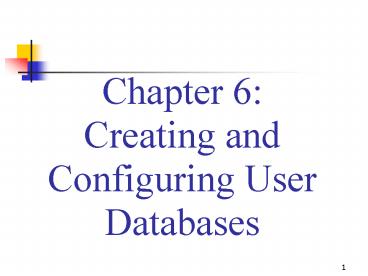Chapter 6: Creating and Configuring User Databases - PowerPoint PPT Presentation
1 / 22
Title:
Chapter 6: Creating and Configuring User Databases
Description:
Type of recovery model, level of database activity, and transaction log backup ... account has Full Control permission under NTFS to the files in the new location. ... – PowerPoint PPT presentation
Number of Views:28
Avg rating:3.0/5.0
Title: Chapter 6: Creating and Configuring User Databases
1
Chapter 6 Creating and Configuring User Databases
2
Chapter Overview
P143
- Creating a User Database
- Setting Database Options
- Managing User Database Size
- Placing Database Files on Multiple Disks
3
User Database Creation
P144-145
- Unique name is required and should conform to
rules for identifiers. - Default values will be used for all unspecified
parameters. - Only members of the sysadmin or dbcreator server
roles can create a new database.
4
Data File Default Values
P145
5
Transaction Log File Default Values
6
Model Database
- Database objects in the model DB
- are used to populate all new databases.
- are inherited by all new databases.
- are inherited by all new databases.
- Default collation of the model DB is inherited by
all new databases.
7
Database Creation Tools
P147-156
- Create Database wizarduseful for novices
creating simple databases - Microsoft SQL Server Enterprise Manager
(directly)graphical method for creating simple
or complex databases - Transact-SQLscript method for creating simple or
complex databases
8
Script Generation
P158-159
- SQL Server Enterprise Manager can create
Transact-SQL scripts for database objects
(including databases, tables, indexes, views,
logins, and groups). - Used to document existing objects for re-creation
on other servers or for disaster recovery. - Use a single script for all objects, or create
multiple scripts for different object types.
9
Database Options
P161
10
Tools for Viewing and Modifying Database Options
P161-162
- SQL Server Enterprise Manager
- The DATABASEPROPERTYEX system function
- The ALTER DATABASE statement
- The sp_dboption system stored procedure
11
Automatic File Growth
P163-164
- Default setting for all data and transaction log
files. - In dedicated SQL Server environments, use only as
a safety valve so as not to cause a performance
hit and data file fragmentation. - Set growth increments large enough so that growth
occurs infrequently, and monitor when the growth
occurs.
12
Automatic File Shrinkage
P165
- Not the default setting for any data or
transaction log files. - Useful for embedded applications and small
installations that are sharing drive space with
other applications. - In dedicated SQL Server environments, perform
shrinkage manually when the database is not busy,
if at all.
13
Manual Data File Size Management
P165-166
- Monitor free space in data files.
- To increase, use SQL Server Enterprise Manager or
the ALTER DATABASE statement. - To decrease, use SQL Server Enterprise Manager,
the DBCC SHRINKFILE statement, or the DBCC
SHRINKDATABASE statement.
14
Manual Transaction Log File Size Management
P167
- Monitor free space in transaction log files.
- Type of recovery model, level of database
activity, and transaction log backup schedule
will affect transaction log file growth. - To increase size, use SQL Server Enterprise
Manager or the ALTER DATABASE statement. - To decrease size, use SQL Server Enterprise
Manager, the DBCC SHRINKFILE statement, or the
DBCC SHRINKDATABASE statement.
15
Additional Data and Transaction Log Files
P168-169
- Create additional data and transaction log files
on separate drives for more space and improved
performance. - Use SQL Server Enterprise Manager or the ALTER
DATABASE statement. - Create additional data files in the primary
filegroup or create secondary filegroups.
16
RAID
P170-171
17
Filegroups
P170-171
18
File Placement
P172-173
19
Tempdb Placement
P174
- Fault tolerance is not an issue, as tempdb gets
rebuilt each time SQL Server starts. - To increase performance, use a separate drive for
the tempdb data file. - Use RAID 0 if using a separate drive does not
eliminate tempdb as a bottleneck.
20
Moving Data and Transaction Log Files
P174-176
- Data and transaction log files can be detached
from a SQL Server instance and then reattached to
the same or a different SQL Server instance. - If files are moved, ensure that the SQL Server
service account has Full Control permission under
NTFS to the files in the new location. - Detached files can be written to a compact disc
for read-only access to data. - Use SQL Server Enterprise Manager, sp_attach_db,
or CREATE DATABASE FOR ATTACH.
21
Chapter Summary
- Default values will be used for all nonspecified
database properties. - Use SQL Server Enterprise Manager to easily
create a new database. - Database options determine default behaviors.
- Use autogrowth as a safety valve only.
- Use multiple drives and RAID for fault tolerance
and performance.
22
Lab
- Lab 4 Creating and Working with Databases
- 75 minutes































